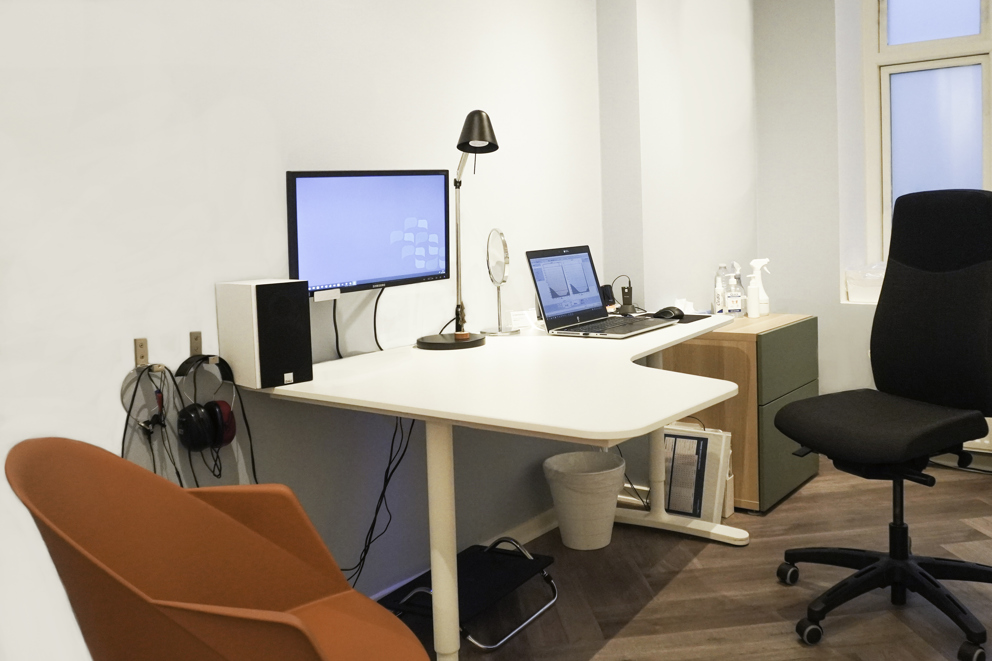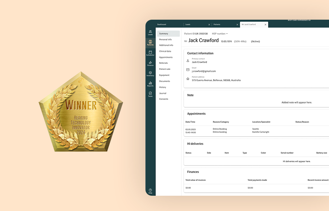
Welcoming a new client to your clinic is all about making a positive first impression. That includes having an attractive storefront, comfortable décor, friendly staff, and personalized care. It’s essential that your hearing center is thoughtful about each of these elements to enhance the customer experience and boost your brand loyalty. However, the welcoming starts way before the first visit. It begins with the first phone call. The first visit's primary purpose is to establish the consumer's hearing challenges, lifestyle, outlook, and motivation to improve their hearing - this will improve the clients’ overall impression of your hearing center.
In this blog, we provide tips and tricks how to:
Hearing Center Entrance & Decor
Consider your hearing center window and signage: what do they say about your business and brand? Your business exterior is one of the first things that any prospective customer observes. Make sure your hearing center’s exterior is professional and well-maintained. Signage should be clearly visible. The building and walkway should be clean, welcoming, and unobstructed. Use your brand’s colors for the hearing center entrance, furniture, signage, and other décor.
Effectively showcase your logo in your window, and draw attention from passing consumers. Create an eye-catching window display. Plan your displays carefully and change them often. Many manufacturers now provide sophisticated Point of Sale (P.O.S.) material that you can use to enhance your window displays.
Hearing center design can be used as a communication channel to attract walk-ins, and reassure clients that they have chosen the right place to do business. Done correctly, hearing center design can inspire clients to purchase hearing solutions, try new accessories, and test new technologies.
The Reception Area
Consider your office set-up from a customer's perspective. They likely don’t view themselves as being sick, so make sure your store doesn’t look like a hospital or traditional doctor's office.
If we look outside the industry, we can see how other medical professionals have successfully positioned their businesses. For instance, modern dentist offices often have a boutique – not clinical – feel. When you go to the dentist, hair salon, or opticians, it’s often set up as a wellness concept. It’s wise to gather tips and tricks from these businesses on how to make a good first impression. We recommend going out and get inspired. Hearing centers can elevate the experience by focusing more on the wellness concept, and less on a clinical look and feel.
Then take a look at your own clinic. When customers walk through your front door, what greets them in your reception area? Is it bright, airy, well decorated and laid out? Does it feel like a welcoming space?
It is better to consider high seated, soft furnishings. High seated furnishings are comfortable to sit in and easy to get up from. It is also important to consider accessibility. Make sure your doorways are wide enough – and your facilities offer enough room – to accommodate wheelchairs. You can also showcase accessories and have trials of these in the hearing clinic.
Instead of offering the typical magazines in the reception area, consider providing copies of your quarterly newsletter. The newsletter should include information about new product lines, new solutions and strategies, news about your staff, and customer success stories. Fill it with details about your business and staff members, as these details encourage customers to get to know you and feel increased loyalty to your hearing center.
Your Clinic Room
Your clinic room needs to be clean and tidy. Clean away any cables, domes, or equipment from your desk between appointments. Always make sure that there is nothing on your desk or your computer screen that may contain identifiable data about another customer.
Consider the placement of your desk, the seating for you, the client and their companion, your PC screens and audiology instruments. Use your screen to involve clients and their loved ones during the consultation to show your findings. Show examples from the client’s hearing examination to make your descriptions and explanations more powerful.
Auditdata’s Measure suite of equipment and software module offers a compact, in-depth, and powerful audiometry tool with clean lines. Easy mounting of the system under a table keeps your desk tidy and allows easy management of cables. Discreet but powerful, the Measure Software provides a modular approach allowing you to choose the test protocols you need. Auditdata Measure Family has a very clean and simple look, keeping your clinic room clean without too many cables laying around.

Your Staff
Your staff members are pivotal to your business and should be welcoming, friendly, and professional. Set out a clear strategy for them to follow, and train them on scripts. Staff should be encouraged to build positive relationships with customers and their relatives. Make sure your audiologists don’t look too “clinical,” as this might be intimidating. Remind the staff to warmly invite the client to the examination room.
Explain how you want every customer to be welcomed, the information they should check, and how they can set a good atmosphere. These elements help speak to your brand, allowing each customer to feel comfortable, cared for, and valued.
Ensure that your staff members look up each customer in the Practice Management Software to create a more personal experience. Remember the “soft stories” about each client’s new dog, wedding, grandchildren, etc., and work these personal details into your conversation to make your clients feel important and welcomed in your hearing clinic.
Understanding Your Client’s Needs
The first thing you should do when the client meets the audiologist is to conduct an interview. The interview stage takes up to 20 minutes to determine the situation. When undertaken correctly, it will set you apart as a professional consultant instead of simply a hearing aid salesperson. The interview portion allows you to understand your prospect and their challenges, needs, emotional state, and the impact of their hearing loss on their life. Involve their loved one in the interview process, as they can provide valuable information and insights about the client’s hearing loss and the implications on their daily life.
The most important thing during the consultation is to use open-ended (not yes-no) questions and to listen carefully to the customer’s answers. Determine information about their lifestyle and how their hearing loss impacts their life. Stay attentive and engaged. Rely on your interpersonal skills to learn more about the customer’s specific needs, formulating your questions in a friendly, non-confrontational way.
Your consultation should include an introduction, some icebreaking conversation, confirmation of the customer’s details, and a medical history. Throughout your conversation, explain the process to put the customer at ease and remove the fear of the unknown.
Having a set structure is helpful because you can stay on track even when the customer has many questions. Questions to ask during the initial consultation should include:
- Does the customer accept that they have a hearing problem?
- Are they committed to doing something about their hearing loss?
- What are the customer's difficulties and lifestyle needs?
- Which activities are challenging to the client today but something they wish to re- engage in?
- Do they own a smartphone? (It’s good to know how comfortable they are with technology and which features might work best for them.)
- Are any medical conditions contributing to their hearing loss?
While it’s helpful to follow a basic script, your staff must understand that every client is different and, therefore, every consultation will be different. Be flexible and customize your approach depending on the client’s personality, specific issues, and answers to your questions.
If the consumer responds unexpectedly or raises a new issue that’s pertinent to their hearing loss, listen to what they’re telling you and use this information to determine how to proceed with their care.
Free Guide
How to Convert More Leads into Paying Customers
Acquiring new leads for your hearing clinics can be both time-consuming and expensive. It's crucial for your team to be fully equipped for each scheduled visit, maximizing every interaction with potential clients. This guide offers a meticulously planned appointment blueprint, coupled with insights and strategies for creating a compelling journey for first-time hearing aid users. This approach empowers your team to offer a consistently high-quality customer experience, thereby increasing the conversion of leads into loyal clients.
Understanding Their Outlook and Motivation
As part of the interview, ask the customer about their feelings towards hearing aids to determine their attitude towards them. Some people may be more open to wearing hearing devices, while others may resist them because of the perceived stigma, associated cost, or other factors. Provide information about hearing aids and equipment, models, price range, and technology. Reassure them that hearing solutions will improve their hearing difficulties and enhance their life, while being encouraging and sensitive to their concerns.
At this stage in the process, you’ll want to provide information and advice. Gently identify any objections and try to clarify what’s at the root of their concerns. Be ready to answer any questions, including questions about price points. Keep in mind that your goal here is an exchange of information. You’ll provide information about hearing aid options, while gathering more details about the client’s specific circumstances and possible objections. This is not a sales pitch.
Assessing Their Lifestyle Problems
When discussing the impact of their hearing loss and their lifestyle needs, it is worth using a document like the Client Orientated Scale of Improvement (C.O.S.I.). The C.O.S.I. is one of the most powerful tools available to encourage emotional engagement with each customer, and it is imperative that you handle it well. As part of this conversation, use words like when, where, how, why, encouraging them to provide details about their hearing challenges and frustrations. Listen carefully to their answers. Even if you feel like you have heard it all before from other clients, this may be the first time this person has vocalized their problems.
Answering your questions may be emotional for your customer. Let them know you’re listening, and ask thoughtful, respectful questions when following up.
Ensure that you cover each problem area intensively and capture all details. Recording this information in your practice management software allows you data access throughout the customer journey. Auditdata’s Manage solution allows you to keep careful records and quickly get an overview of each customer’s history and details.
By following this protocol, you can better understand their specific issues and possible objections. This approach will allow you to engage with your customers more deeply and, ideally, build a long-term relationship with them.
Use the information you have gathered until now, and remember to use this actively when doing the examination and when you present the solution to the customer. It is all about ensuring that you give a personalized experience and keep the clients in the center at all times.
Resources:
Other Blogs You Might Enjoy:

The Role of the Front Office in Maximizing Patient Retention
The front office staff plays a pivotal role in providing a Best Care Experience for every patient. This blog explains how your front office team can increase patient retention, enhance the patient journey, and improve patient interactions to maximize customer satisfaction, loyalty, and retention.

Why People Don't Wear Their Hearings Aids - Responding to Common Hearing Aid Objections
No one wants to have a hearing loss, and most people are not excited about the prospect of needing hearing aids. How can you, as a hearing care provider, help them overcome the barriers and realize the benefits of getting hearing aids?

A Hearing Clinic’s Flexibility is a Key to Success
Provide the highest quality care for customers and make the treatment process as easy and convenient as possible. Offer extended hours, keep the schedules running smoothly to prevent long wait times, and offer same day emergency appointments. By doing so, you’ll attract new prospects, elevate your customer service, and boost client loyalty and satisfaction.
Don't Miss Out On the Latest Insights On Audiology
Sign up today to receive exciting updates, tips, and the latest newsletters from Auditdata.





